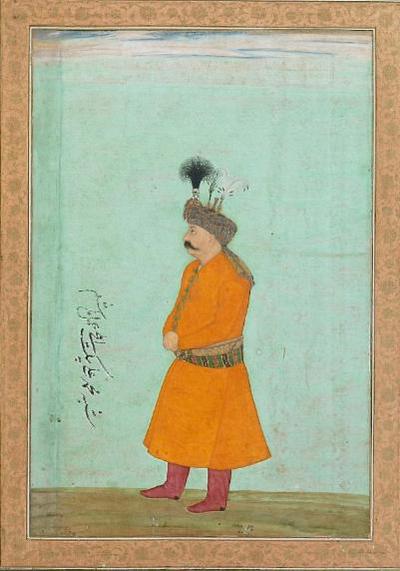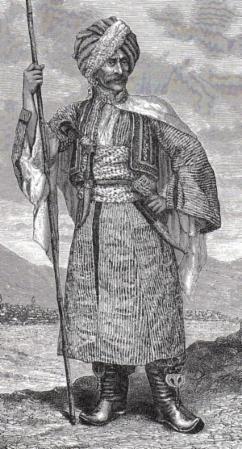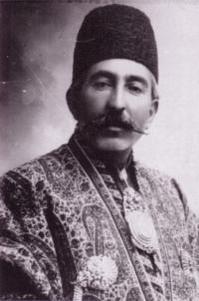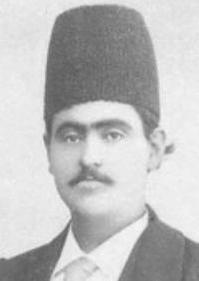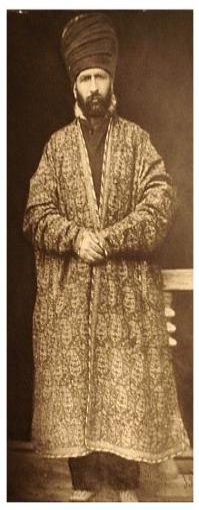| The Heroic and Historic Era The Kurdish Era The Qajar Era The Pahlawi Era | The Zarrinkafsch-Bahman (Qajar) Family |
“Once
upon a time in the land of Shahrizor there ruled a tyrant king named
Dhahak from Mesopotamia, who was in connection with the world of demons. From both of
his shoulders grew a snake’s head, always hungry. To calm down these
beasts they had to been feed daily with the brains of two children. One
day the king’s servants had the idea to take lambs instead of the poor
children in order to feed the snakes with the animals’ brains. The
camouflage worked and the children safed this way were brought away and
entrusted in the high mountains’ care. Here they formed the beginnings
of the Kurdish people. However, Kaveh the Blacksmith, who lived in
Dhahak’s realm, had lost eight of his children to this bloody tyrant.
When it seemed that he will loose his ninth and last child, anger and
despair came over him and he draped his leather apron from a wooden
spear as a standard, and under this banner he call the people on Mount
Kalikawa to revolt. They attacked the tyrant’s palace, overwhelmed his
guards and ended his rulership, when the king was killed by Kaveh
himself with his sledgehammer. This raising, which founded the Kurdish
people’s freedom took place on the 21 March of 1234 before Hijjra (612
BC)…”
This
date was also the year, when the ancient Medes defeated the Assyrian
Empire and founded the first Iranian state based in today’s Kurdistan. Nearly two thousand years later, in 1177, the region of Media was named Kurdistan (i.e. "Land of the Kurds") and became a province of the Seljuq Empire (1138 to 1194). The Kurds were an old Western Iranian (Aryan)
race tracing back to the ancient Medes and Islamized in the 7th
century. According to old common feudal patterns they had a stringent
social hierarchy and their area was divided into several fiefdoms (beylik), ruled by chieftains of the local tribal aristocracy, called Mir, Beyg
and Agha.
In the following centuries this region became a battlefield and
puffer-zone between the Turkish sultans of the Ottoman Empire and the
Iranian shahs of the Persian Empire.
In 1501 the first ruler of the Persian Safavid Dynasty, Shah Esmail
I Safavi (r. 1501-1524), founder of the modern Persian Empire,
conquered all of Kurdistan and made it a Persian domain. His successors
lost a great part to the Turkish Ottomans in different battles, but in
1603 the 4th Safavid Shah Abbas
I the Great (r. 1589-1629) started to reconquer the Kurdish provinces
for Persia. Also, becoming the "remaker of Iran" he restricted the
political power of his Turkic Kizilbash elite, which once had
supported his dynasty to get the crown, and assigned provincial Persian
notables for governmental service. Thus, during his reign our own family began to reach local prominence in Kurdistan when through fourteen generations
and four hundred years its members were installed in military and
administrative posts by several Persian shahs from the Safavid (1501 to
1722), Afsharid (1736 to 1796) and finally Qajar (1785 to 1925) dynasties, as well as in state offices by the Kurdish Ardalan rulers (1187 to 1867). These brave men were beygs or tribal Kurdish rulers:
1. Mohammad Ali Beyg "Zarrinnaal" Mohammad Ali Beyg, who was called by nickname "Zarrinnaal" (lit. "Golden Horseshoe"), was
ordered by Shah Abbas I the Great
to make war on the Ottomans; and on 24th of August 1605 with the aid of
his troops from the Mokri tribes could reconquer the Turkish occupied
province of Kurdistan for Persia. After that he was made vicegerent (wali) of Kurdistan and reigned probably from 1609 to 1615 as governor and was head of the administration and army, chief judge and legislator. There, he himself and his entire tribal confederacy (il) were known and henceforth called by the name of "Zarrinnaal". His family belonged to the Kurdish clan of Zarrinkafsh from Sanandaj, and went far back to Abu al-Fawaris Zarrinkafsh, a local notable in the 1090's during the Seljuqs and a chief accountant of the Shiite tombs in the city of Rayy. The family settled in Sanandaj minimum since the year 852 A.H. (1448 A.D.) and possessed that area as their hereditary fief (beylik).
In 1631 Mohammad Ali Beyg was Persian ambassador to the Mughal court of India sent by Shah Abbas to went in further negotiations about the Province of Kandahar. Kandahar, one part of the Mughal domains, was given by Humayoun to Shah Tahmasp, and then annexed by Humayoun's successor Akbar. In 1622 Shah Abbas reconquered the area and regarded it as his legal heritage. A peace treaty with Jahangir should secure this status quo. Arriving in time for the New Year festival in March 1631 Mohammad Ali Beyg arrived in India and remained there until October 1632.
"Portrait of Mohammad Ali Beyg, the Ambassador, the work of Hashim."
About the origin and meaning of the name "Zarrinnaal" there are different stories: Ahmad Zarrinnaal told that our ancestor fought against the Russians and his horse bore in war golden horseshoes (Pers. Zarrin Naal). Kazem Zarrinnaal/Zarrinkafsch told a version also written down by Mirza Mohammad Taqi Sepehr Kashani "Lesan ol-Molk" in his historical chronicle Nasekh at-tawarikh, that this ancestor was sent as Persia's envoy to Mughal India for border negotiations with the neighbor. To show his wealth on this
special ceremonial occasion and to convince his partners to agree, he
once put golden horseshoes on his horse. A third story reports that this happened when this forefather asked the shah for the hand of his daughter. First the shah said no but when the Kurd came on a horse with golden horseshoes to the palace to impress the king and to pick up his bride, the shah finally agreed. At least when this ancestor took a ride the animal lost its horseshoes, people picked them up and soforth nicknamed him Zarrinnaal and finally called his entire clan the very same way. Hence, his descendents were titled Zarrinnaal after him.
However, in fact the term "Zarrinnaal" in modern Persian of today means "Golden Horseshoe" with "naal" meaning "horsehoe", but "naal" is also the nominative singular of the Arab word "na'aleyn" meaning "shoes, slippers". Thus "Zarrinnaal" as well could mean "Golden Shoe" in an Arabized more elaborated way, often used in old days and especially among the Kurds!
2. Mohammad Zaman Beyg
Mohammad Ali Beyg's son Mohammad Zaman Beyg was a merchant and traveller.
After Shah Abbas'
death the Ottoman vizier Khusrew Pasha attacked Kurdistan in 1634 and
destroyed its capital city of Hassanabad. But next to it Sehna or
Senneh, the modern city of Sanandaj
was built as new residence and capital for the Ardalan emirs by Wali
Soleyman Khan Ardalan (r. 1636 to 1657). Thus, the entire Kurdish
tribal elite moved to the new capital of Sanandaj, which became a
prosperous city. Thereby the name of Sanandaj comes from the Kurdish
terms Sena meaning "soltan" or "ruler" and Daj (or Dezh) meaning "fortress", and thus means "The Ruler's Fortress", which refers to the wali's stony fort on top of the city peak Teppeh-ye Painshahr (Teppeh-ye Tus-Nozar).
With the Sorani-Kurds of Ardalan coming in the area of the Gorani-Kurds in Iran and finally settling at Sanandaj, the Zarrin Kafsh tribe was incorporated into the Bani Ardalan tribal federation and the Zarrinnaal family belonged to the Ardalanic nobility.
In 1638 the common modern Turkish-Persian border was established at the
foot of the Zagros Mountains between Mesopotamia and the Iranian
Plateau.
3. Mahmoud Beyg Soltan
Mohammad Zaman Beyg's son Mahmoud Beyg Soltan was army captain and provincial sub-governor (soltan). In Safavid time the military aristocracy of the emirs was divided in the three ranks of khan (i.e. "magnate", title of military commander), beyg (i.e. "lord", title of tribal chief) and soltan (i.e. "ruler", title of provincial sub-governor).
4. Mohammad Beyg
Mahmoud Beyg Soltan's son Mohammad Beyg was vicegerent (wali) of the Afghans (i.e. Pashtuns) after he was deputy governor (nayeb-e wali) in today's Afghanistan. The province of Afghan with its capital of Kandahar belonged to the Safavid Empire until 1709.
5. Hajji Eskandar Beyg-e Afghan
Mohammad Beyg's son Hajji Eskandar Beyg-e Afghan was a leader of the Afghans (Beyg-e Afghan) and after his arrival in Kurdistan from a pilgrimage to the Holy City of Mecca he settled there again at Sanandaj.
In 1709 Ghilzai-Afghan rebels under their chief Mir Wais rose against
the Persians, killed the Safavid governor of Kandahar, the Georgin
Gurgin Khan (King Georgi XI) of Karthli, they declared their
independence and finally caused the downfall of the Safavids when they
seized and at last sacked the Safavid capital city of Isfahan in 1722.
6. Abbas Beyg "Wazir"
Hajji Eskandar Beyg's son Abbas Beyg was vizier of Persia (wazir-e Iran), had issued 18 children and was the head of his tribe (rais-e il).
He served under Nader Shah Afshar (r. 1736-1747), who reinstate the
Persian monarchy but was a brutal tyrant too, and was murdered by his
own emirs in 1747. The Afshar and Qajar emirs allied with one of the
shah's envoy and minister, Hossein Ali
Beyg, while on a campaign entered the ruler's tent and cut off his head
and also killed his two other ministers, Bader Khan and Abbas Beyg "Wazir".
7. Oghli Beyg I
Abbas Beyg's son Oghli Beyg I was landlord (mallak) of a big estate in Kurdistan under the walis of Ardalan.
8. Ali Beyg "Monshi-bashi" Oghli Beyg's son Ali Beyg "Monshi-bashi" was in the year 1799 chancellor and chief secretary (monshi-bashi) of Wali Amanollah Khan Ardalan I (r. 1797-1825), one of the most powerful and popular rulers of Kurdistan. Responsible for the army's administration and Amanollah Khan's military power Ali Beyg was killed 1826 at the battle of Mossul by Ottoman troops.
9. Oghli Beyg II "Monshi ol-Molk"
Ali Beyg's son Oghli Beyg II "Monshi ol-Molk" was landlord and, like his father, ministerial (monshi) of the walis
of Kurdistan in army service. After he quitted his service for the Ardalans (Khusrow
Khan, r. 1825-1834; Reza Qoli Khan, r. 1834-1860, and Amanollah Khan
II, r. 1860-1867) in the last years of his life he only looked after
his estates in Kurdistan.
Khusrow Khan followed his father Amanollah Khan I but died young by poison. His two sons struggled for power over their father's domains, fightened against eachother and in the Kurdish Ardalan domains a civil war broke out until Nasser od-Din Shah Qajar deposed Reza Qoli and terminated the Ardalan rule after Amanollah's II death.
Like most of all
Kurds Oghli Beyg II was a Sunni Muslim but for political reasons converted to the
Shiite faith of Islam, the main religion in the Persian Empire. Oghli
Beyg wanted to join his own family with the new established Qajar
dynasty by marriage, and asked for the hand of Princess Noor-Jahan
Khanom, the 9th daughter of Crown Prince Abbas Mirza "Nayeb
os-Saltaneh". By her he got two sons. After the young princess unfortunately died he re-married Noor-Jahan Khanom II ("Noorjan Khanom") Ardalan, a daughter of Wali Amanollah Khan Ardalan, sister to Khusrow Khan and aunt to Reza Qoli and Amanollah II. By his second wife he issued his daughter.
Drawings of the Kurdish Aghas of Senneh, Ali Beyg "Monshi-bashi" and Oghli Beyg "Monshi" made by C. Lapente and published around 1870.
Relations of the Zarrinnaals to the Ardalan Family
The relations of our family with the Ardalan dynasty which ruled (Persian) Kurdistan as princes and hereditary governor-generals until 1867 are various:
- Shah Abbas appointed Mohammad Ali Beyg Zarrinnaal to Wali of Kurdistan as a counterpart to the Ardalan princes.
- Wali Soleyman Khan Ardalan chose 1634 the old Zarrin Kafsh fiefdom of Senneh (Sanandaj), the Zarrinnaal's original hometown, as his new capital, so the Zarrinnaal became members of the Ardalanic nobility.
- When after the Afghan debacle 1709-1720 the Zarrinnaal Hajji Eskandar Beyg-e Afghan came back to Kurdistan, his family again settled in Sanandaj and became prominent members of the Ardalan princely court especially with Wazir Abbas Beyg "Rais-e Il", chief of that tribe which ruled the whole area for centuries, Oghli Beyg as big landlord and Ali Beyg "Monshi-bashi" (1770-1826) and Oghli Beyg Zarrinnaal II "Monshi ol-Molk" (1808-1868) as hereditary chief secretaries to the Ardalan princes.
- Oghli Beyg II married Noor-Jahan (Noorjan) Khanom, daughter of Wali Amanollah Khan Ardalan I.
- Their both daughter Zarrin-Taj (1860-1884) married her cousin Abol Hassan Khan Ardalan "Fakhr ol-Molk" (1862-1926) as his first wife and was the mother of Gholam Reza Ardalan "Fakhr ol-Mamalek". While their son Agha Mirza Zaman Khan left Sanandaj for Tehran to make carreer at the Qajar Imperial court of Nasser od-Din Shah...
- Shah Abbas appointed Mohammad Ali Beyg Zarrinnaal to Wali of Kurdistan as a counterpart to the Ardalan princes.
- Wali Soleyman Khan Ardalan chose 1634 the old Zarrin Kafsh fiefdom of Senneh (Sanandaj), the Zarrinnaal's original hometown, as his new capital, so the Zarrinnaal became members of the Ardalanic nobility.
- When after the Afghan debacle 1709-1720 the Zarrinnaal Hajji Eskandar Beyg-e Afghan came back to Kurdistan, his family again settled in Sanandaj and became prominent members of the Ardalan princely court especially with Wazir Abbas Beyg "Rais-e Il", chief of that tribe which ruled the whole area for centuries, Oghli Beyg as big landlord and Ali Beyg "Monshi-bashi" (1770-1826) and Oghli Beyg Zarrinnaal II "Monshi ol-Molk" (1808-1868) as hereditary chief secretaries to the Ardalan princes.
- Oghli Beyg II married Noor-Jahan (Noorjan) Khanom, daughter of Wali Amanollah Khan Ardalan I.
- Their both daughter Zarrin-Taj (1860-1884) married her cousin Abol Hassan Khan Ardalan "Fakhr ol-Molk" (1862-1926) as his first wife and was the mother of Gholam Reza Ardalan "Fakhr ol-Mamalek". While their son Agha Mirza Zaman Khan left Sanandaj for Tehran to make carreer at the Qajar Imperial court of Nasser od-Din Shah...
Amanollah Khan Ardalan (r. 1846-1848, 1860-1867).
To continue to The Qajar Era - click here
This website was created by Arian K. Zarrinkafsch (Bahman-Qajar).

